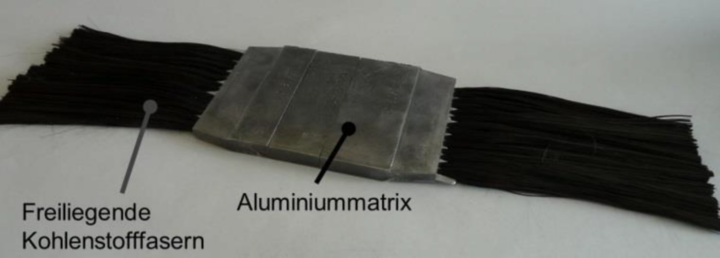This working group at the institute deals with innovative processes for joining metal and fiber materials. Based on shaping in a semi-liquid material state, processes are being developed that enable a combination of the materials used that is suitable for the design and load and overcomes the disadvantages of conventional manufacturing processes. The manufacturing routes investigated are based on the infiltration of the fiber (bundle) interstices by a semi-liquid aluminum matrix, which creates a strong bond between these dissimilar materials. In detail, short and long carbon fibers with different conditionings - AlSi matrices - as well as ceramic and glass fibers in different applications are being investigated.
Process sketch and successfully joined sample (Al-carbon fabric-AL) with circular joining zone
As part of this research project, the institute is working on the development of a new process for joining carbon and metal structures. In this process, which is based on shaping in a semi-liquid material state, two aluminum sheets are heated conductively by means of two electrodes to a temperature level just above the solidus temperature of the aluminum, so that an intermediate carbon fabric is infiltrated by the semi-liquid material and a firm bond is created between the sheets and the fabric. After the experimental improvement of the control of the heating process in the first year of production, the heating of the sample could be simulated in the second year of production. In addition, the influence of various parameters could be worked out so that up to 25 carbon layers can be bonded with aluminum using precisely defined heating powers and electrode pressing forces. In the last research phase, final strength tests and electromicroscopic analyses of the fiber-metal interface will be carried out. Finally, the numerical modeling of the process will be supplemented by the simulation of the fabric infiltration through the aluminum matrix.
Duration: 01.2015 - 06.2017
Continuous fibers embedded in an Al-Si matrix in certain areas
The aim of this research project is the material-appropriate joining of fiber-reinforced composite profiles, which is to be achieved through the transition from polymer matrix composites to metal matrix composites at the nodal points of load transfer. For this purpose, the polymer matrix in the nodal area is substituted with a metallic matrix, enabling the full exploitation of the significant potential of fiber-reinforced plastic profiles with respect to material savings, CO2 and mass reduction, as well as their outstanding structural properties. To achieve this, a tool was designed, constructed, simulated, and subsequently manufactured for the shaping of semi-liquid Al/Si alloys. This forming tool allows for the partial infiltration of fiber-like reinforcement components in the form of carbon or glass fiber rovings with semi-liquid or liquid aluminum materials. Subsequently, it is possible to apply a polymer matrix to the exposed fiber ends, thereby realizing the desired transition. The results of the forming trials conducted demonstrate that an almost complete infiltration by the metallic matrix is possible without damaging the fibers. The manufactured load introduction zones exhibit higher performance compared to standardized pultrusion profiles in this load introduction area. In further research, alternative component geometries will be realized and analyzed with regard to their mechanical properties.
Duration: 01.2011 - 08.2014



